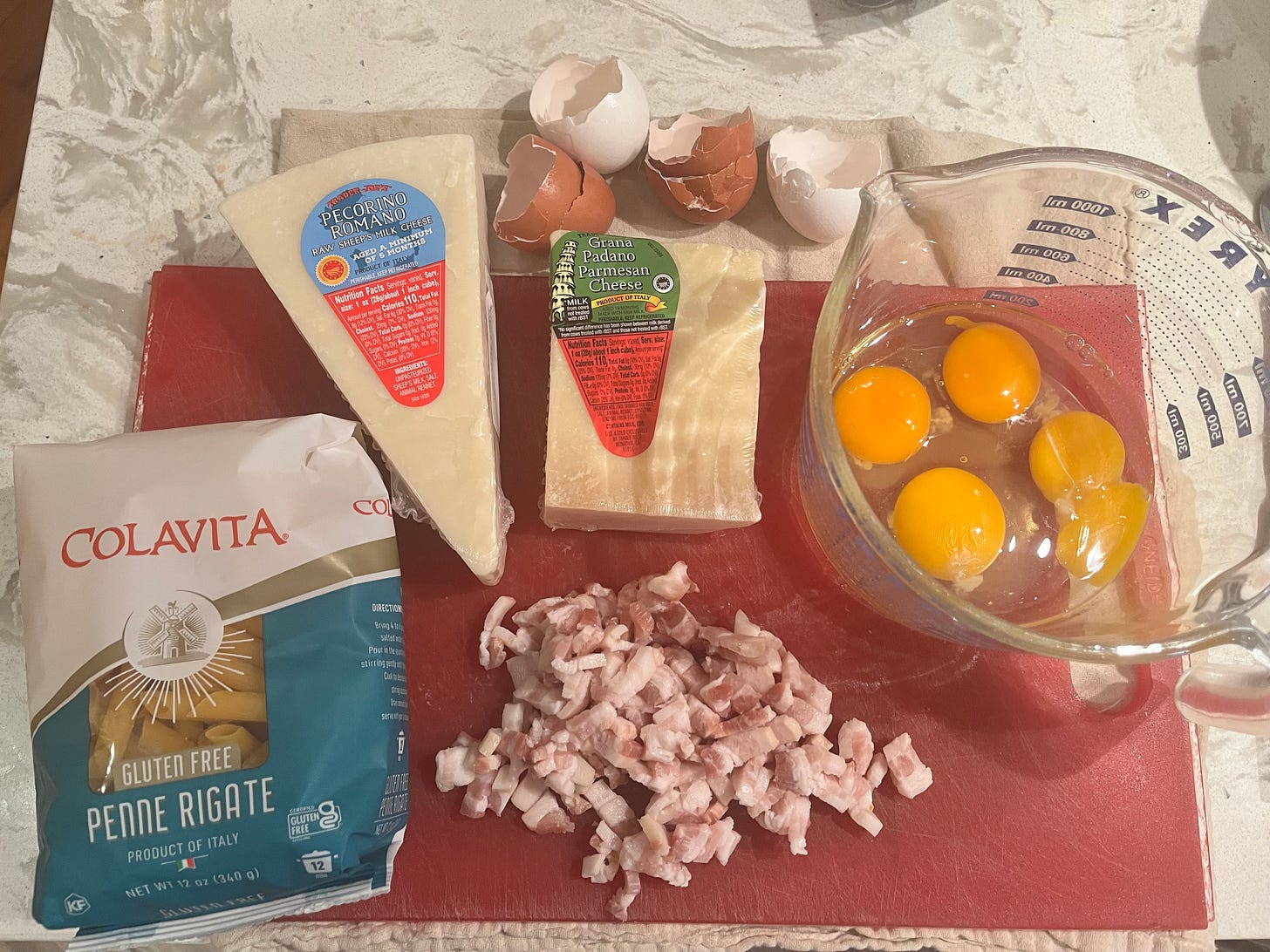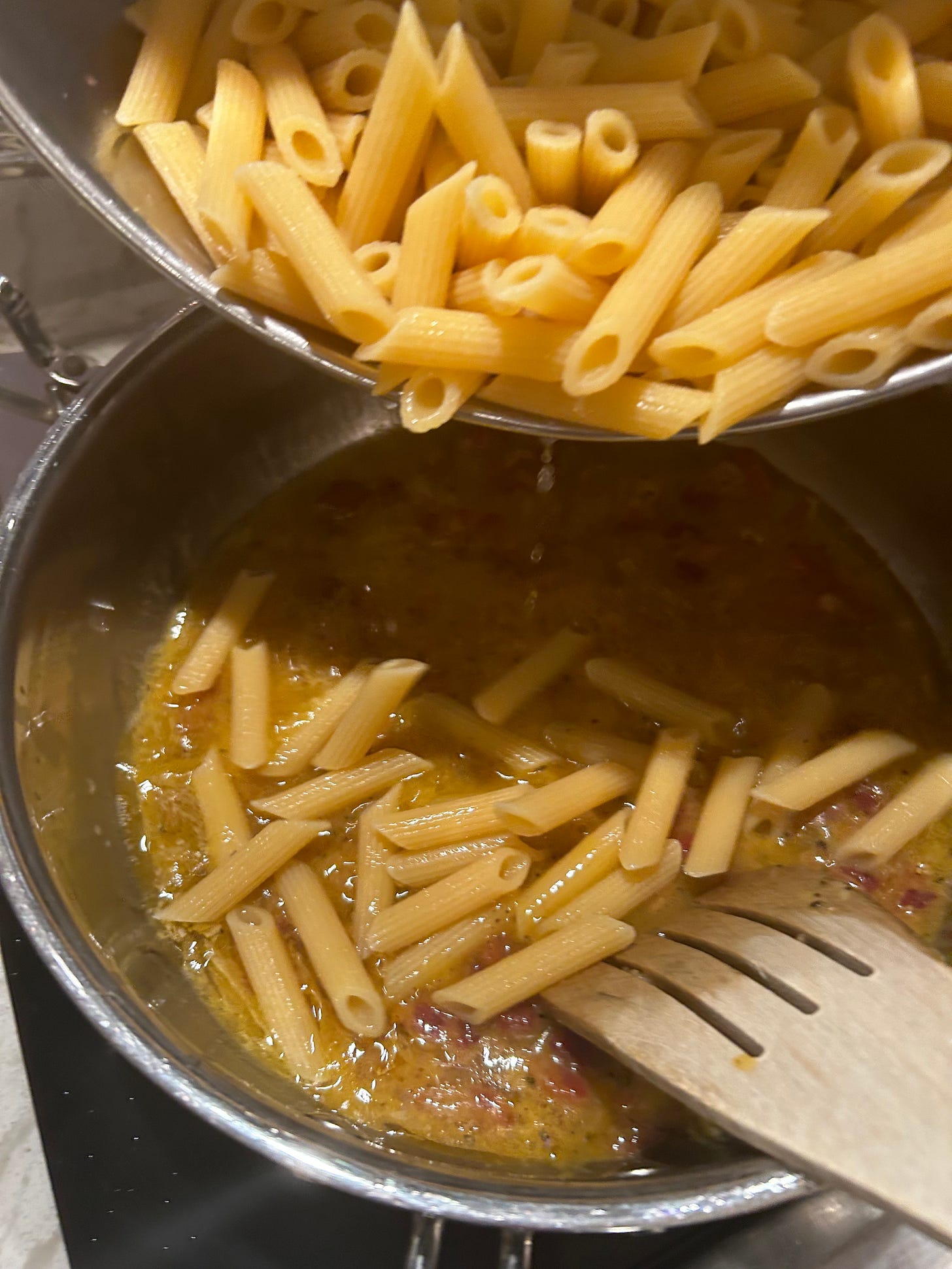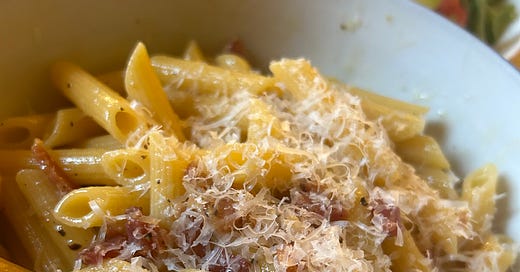Bacon, olive oil, eggs, cheese, pasta, black pepper—and you’re done. This is a very simple, fast pasta recipe to make, and I often fall back on it when I haven’t planned ahead or have little time to cook. There is one slightly tricky part, though—the egg sauce should be liquid, not scrambled, which is how it can turn out if the pan is too hot when you add the eggs. That’s why in the recipe, I suggest removing the pan from heat for 3 minutes before stirring in the beaten eggs.
Serve with a salad tossed with vinaigrette, and you’re set!
Be sure to check out the cat update at the bottom of this post.
Ingredients:
1 12-ounce package gluten-free penne (see note 1)
4 ounces bacon, guanciale, or pancetta, chopped (about ¾ cup) (see note 2)
2 tablespoons extra-virgin olive oil
4 large eggs at room temperature (see note 3)
2 heaping tablespoons freshly grated Pecorino or Parmigiana cheese (see note 4)
Freshly ground black pepper
For the pasta water: 1 tablespoon sea salt
For serving: grated Pecorino or Parmigiana cheese, or a mix of the two, and black pepper

Instructions:
Put 4 to 5 quarts of cold water in a large pot and place it on the burner over high heat
Heat the olive oil in a large sauté pan (large enough to hold the pasta after it is cooked) over medium-high heat
When the oil is hot, add the chopped bacon, guanciale, or pancetta and fry until crisp
While the bacon is frying, crack 3 of the eggs into a mixing bowl; with the fourth egg, separate the white from the yolk and add the yolk to the bowl (see note 5)
Add the two tablespoons of grated cheese and a generous grind of black pepper (at least ¼ teaspoon, or more to taste) and beat the eggs just until everything is thoroughly mixed (see notes 6 and 7)
When the water is boiling, add 1 tablespoon salt to the pot, add the dry penne, and set a timer for the cooking time (see note 8)
When 3 minutes remain on the timer, remove the pan with the bacon from heat
After 3 minutes, pour the egg mixture into the pan with the bacon and stir until blended (see note 9)
As soon as the pasta is cooked, drain it and pour into the sauce
Using a spatula or wooden spoon, toss the pasta in the sauce for a minute to make sure the sauce is evenly distributed
Serve with a generous grinding of black pepper and a generous sprinkle of grated cheese

Notes:
I can recommend two brands of penne rigate, both Italian. The one I’ve been using lately is Colavita—it has a very good texture. The other is Barilla.
The traditional way to make carbonara is with guanciale, which is cured pork jowl. Pancetta, like bacon, is cured pork belly. You can find guanciale and pancetta in specialty food shops, but it tends to be pricier than bacon. I’ve used all three, and they all taste good, so there’s no reason not to use the lower-cost bacon. Should the bacon be smoked or unsmoked? Again, both ways taste good, so use whatever is available to you.
As I mentioned, I often make this when I haven’t planned ahead, so the eggs are typically still in the fridge when I decide to make it; the first step should be to take the eggs out of the fridge to give them a chance to warm up a bit. Also, if you crack into the bowl right away, that will help take the chill off.
A very hard, dry Italian cheese like Parmigiana or Pecorino works best for this recipe, but I’ve also eaten it with friends who made it with other grated hard cheeses, like Gruyere or Emmenthaler. If what is available to you is a package of grated Swiss cheese, by all means use it! It will still taste good, and our goal is to make something delicious that you’ll want to eat, not to be as authentic as possible.
The method I use to separate the white from the yolk is to crack the shell so that it breaks into two more-or-less even halves. Hold the halves over a bowl and tip the yolk from one half shell to the other, and dump the white that is left in the first shell into the bowl. Repeat that move two or three times, and most the white should be gone, leaving just yolk in the half shell. You can save the egg white for another use. Egg whites freeze well, so you can save them in the freezer. I usually end up with so many egg whites in the freezer that I end up tossing some of them out. But there are some good recipes for using egg whites, and I hope to give you some later.
One quick historical note on black pepper in Roman food: In a book I’ve been reading about the ancient Silk Road trading route from Asia to Europe, I learned that one item the ancient Romans imported from India was black pepper, so the citizens of Rome have been using black pepper to season their food for a very long time! No wonder it is such a common ingredient in Roman recipes.
The traditional recipe doesn’t include adding salt to the egg sauce. In theory, the bacon should have enough salt to flavor the dish, but in reality, I often find the dish needs more salt, so I typically add a pinch of fine sea salt to the eggs at this point as well.
I always set the timer for a couple minutes short of the cooking time recommended on the package. The goal is to serve the pasta al dente—which means it is firm enough to resist your bite without being crunchy. I’ve found that, usually, the ideal al dente cooking time is a couple minutes shy of the recommended time. Always taste a piece of pasta before draining, to be sure it is cooked to your liking.
Again, the sauce should remain a liquid, and the eggs should not cook to become hard like scrambled eggs. If you prefer the eggs to be cooked, I recommend making a frittata instead! Come to think of it, a frittata recipe is something I should write up soon!
Cat update:
Seraphina is pouting, because she knows I’m about to go away for a few days. She’s taken over the packed suitcase. She wasn’t happy when I gently lifted her out.





